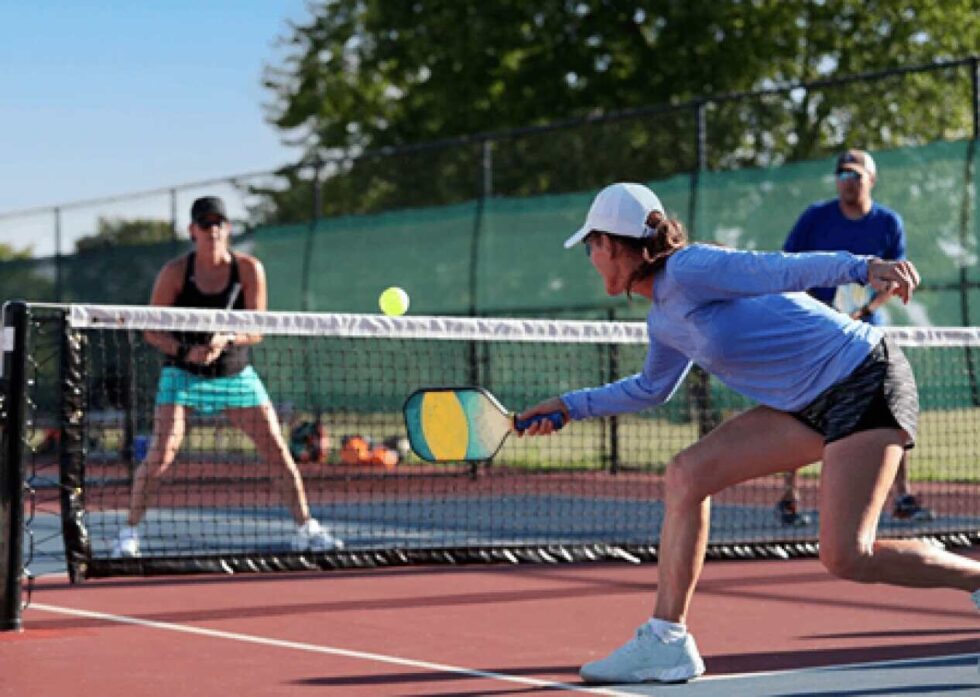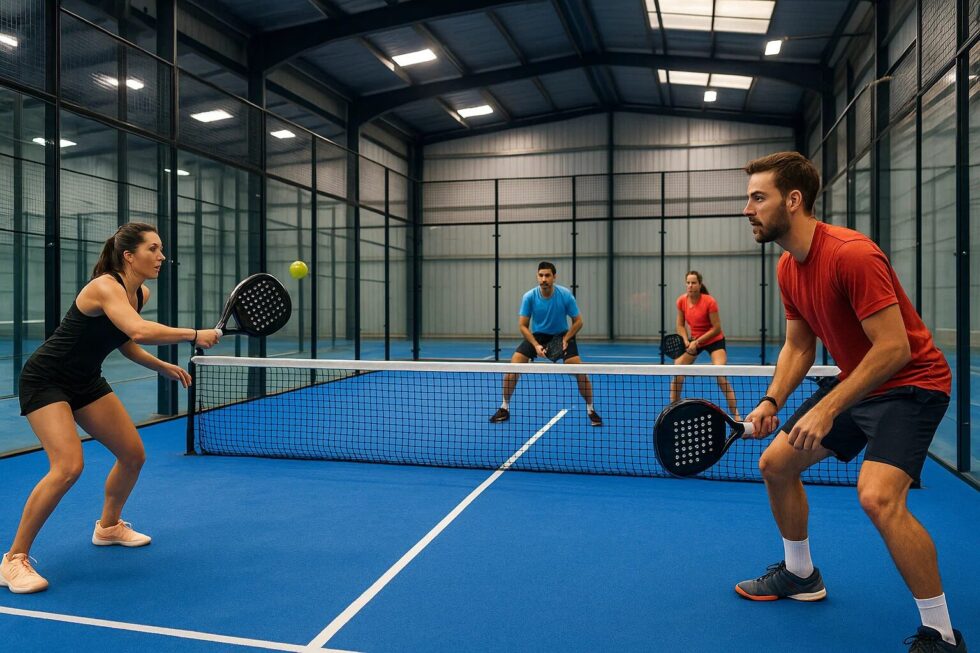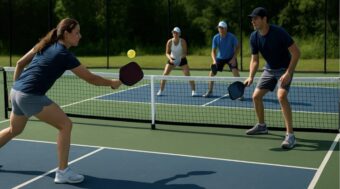How to Play Pickleball Rules Right and Why Is the Sport Trend Rising in Germany

Pickleball Regeln are gaining massive popularity across Germany as the game transforms from a casual pastime into a structured Sporttrend embraced by all ages. Combining the best of tennis, badminton, and table tennis, pickleball offers simple rules, affordable equipment, and a strong social element that brings people together — from weekend players to competitive athletes. Over the past two years, dozens of German cities have opened new courts, while tennis clubs have added pickleball lines to meet demand. Fitness centers and corporate wellness programs are integrating it as a fun and low-impact activity suitable for everyone. According to the editorial team of G.business, the rise of pickleball in Germany reflects a wider cultural shift toward accessible, community-based sports that promote both health and connection. With this surge in popularity, learning how to play pickleball correctly has become essential for beginners who want to join the movement and enjoy the fastest-growing sport in the country.
Understanding the fundamentals of pickleball rules
Pickleball is played on a rectangular court roughly 6.1 by 13.4 metres, using a lower net than tennis and a perforated plastic ball designed for predictable bounce and flight. Serves are executed underhand with paddle contact below the server’s waist and must travel diagonally into the opponent’s service box; the serve must clear the non-volley area in front of the net. After a legal serve both sides must allow the ball to bounce once before volleys are permitted — the double-bounce rule — which intentionally neutralises immediate attack and extends rallies. Points are traditionally scored only by the serving side and most recreational games use an 11-point target, win by two; tournament formats may use 15 or 21 to structure brackets. The court contains a 2.13-metre non-volley strip — commonly called the kitchen — where players may not volley the ball; stepping into that strip to volley is a fault. Faults also include serving incorrectly, hitting the ball out of bounds, and volleying before the double bounce has occurred. Grasping these rules early builds confidence: beginners who practise serves, get comfortable with the double-bounce dynamic and respect the kitchen can begin rallying within a single session. Below is a compact summary that beginners can print or memorize as a quick checklist.
- Quick checklist for beginners:
- Serve underhand, paddle below waist, diagonal
- Let ball bounce once each side before volleying
- Do not volley inside the 2.13 m non-volley zone
- Only serving side can score (recreational play)
- Standard game to 11 points; win by two
Step-by-step practical plan to learn how to play correctly
A structured approach accelerates progress more than random play: begin with movements and ball feel, then isolate serve and return, then practice dinks and volley timing, and finally combine these into match scenarios. Start sessions with 10 minutes of mobility and shadow swings to prime balance and lateral motion; follow with 15 minutes of focused serving drills aiming diagonally to a marked zone, then 15 minutes of return and deep placement work. Spend another 15 minutes on kitchen-line dink exchanges — slow, controlled soft shots that teach touch and patience — before moving back for baseline drives and overhead stabilisation. Finish with 10–15 minutes of short sets (to 5 or 7) to apply scoring rhythm and court rotation under light pressure. Track simple metrics: serve success rate (percentage in), average rally length and number of unforced faults per set; small measurable gains indicate reliable improvement. Rotate partners frequently in doubles practice so every player learns both the server and returner roles and the sideline transition. Use a stopwatch or phone timer to keep sessions disciplined and avoid fatigue-driven sloppy technique. Below is a ready session template beginners can copy for repeated practice.
- Sample beginner session template:
- Warm-up (10 minutes): dynamic stretches, footwork ladder or side-shuffles
- Serving practice (15 minutes): target zones, underhand motion
- Return & depth drills (15 minutes): returning deep to baseline
- Dink/kitchen exchanges (15 minutes): soft control and patience
- Baseline drives & volleys (10 minutes): power control and reset
- Short match play (10–15 minutes): rotating partners, scoring practice
Why pickleball is taking off in Germany now
Several structural and cultural factors converge to explain why pickleball has found fertile ground across German municipalities, clubs and private facilities. First, the sport is space-efficient: multiple pickleball courts can fit into a single tennis court with simple line markings, which appeals to municipal sports managers seeking to maximise usage. Second, the equipment and entry cost are low relative to racket sports that demand larger courts or specialised balls; a paddle and a few balls are enough to start, and rental equipment lowers the barrier further. Third, the game’s social DNA — short sets, doubles format and mixed-age play — aligns with contemporary demand for inclusive leisure activities that combine fitness with sociability. Fourth, the low-impact mechanics reduce injury risk, making pickleball attractive to older adults and to school sports programmes looking for safe, engaging options. Finally, media visibility and local organisers staging “open play” events accelerate word-of-mouth adoption, creating a virtuous cycle of awareness, trial, and membership growth. These elements together explain the rapid diffusion from a handful of urban hubs to dozens of community venues.
- Main drivers of adoption:
- Space efficiency and easy court conversion
- Low equipment and rental costs
- Short learning curve for all ages
- Low-impact, safe mechanics for older players
- Social, community-oriented play format
Where to begin in German cities and what to expect
If you live in a German city, the fastest route to your first game is to search for “open play” or “beginner clinic” at local sports halls, community centres, or tennis clubs; these sessions typically supply paddles and balls. Expect weekdays and early evenings to be busiest; weekend clinics fill quickly as word spreads among local players. Community clubs often publish simple calendars for court bookings and may offer a free first session to newcomers; municipal leisure offices likewise list seasonal programs. When you arrive for your first session, ask for a five-minute orientation covering serve order, scoring and safety notes — hosts appreciate that newcomers want to learn the basics quickly. Bring non-marking court shoes, a water bottle, and a small towel; if you have friends learning together, rotate duties to keep everyone active. Beginners should plan for at least four to six practice sessions before feeling comfortable with rallies, and several months of regular play to move from confident recreational level to competitive amateur. Below is a practical checklist to prepare for your first club visit.
- First-time player checklist:
- Reserve or register in advance if required
- Arrive 15 minutes early to borrow gear or get instructions
- Wear court shoes and comfortable sportswear
- Bring water and a light snack for recovery
- Ask for quick scoring and serve order recap before play

Equipment, prices and buying advice for newcomers
Selecting the right first paddle and balls makes learning easier: choose a mid-weight paddle (roughly 215–235 g) with a polymer core for a forgiving sweet spot, and start with indoor balls for slower, more controllable rallies. A basic starter setup — paddle, three balls and a portable net if you need one — sits comfortably in a modest budget and rarely exceeds the cost of a single higher-end tennis racquet. Footwear is an often overlooked factor: lateral-support court shoes reduce ankle strain and help with quick pivots; avoid running shoes with forward-biased cushioning. Many clubs offer demo paddles so you can test feel and balance before buying; try two or three models across a single session to determine hand weight preference. Consider incremental upgrades: begin with an affordable paddle, then invest in a higher stiffness or graphite face once your strokes stabilise. Below is a short price guidance table for planning.
- Estimated beginner price guide (approximate):
- Entry paddle: low to mid price range
- Balls (pack): small recurring cost
- Portable net: optional one-time purchase
- Court shoes: medium investment for safety
- Coaching session: variable hourly rate
Common mistakes beginners make and how to fix them
Typical errors are predictable and correctable: rushing into the kitchen to smash, serving with an incorrect arc, neglecting foot movement, overhitting instead of placing, and poor doubles communication are the usual suspects. The antidote is deliberate practice: slow down serves until accuracy reaches 80% in drills, spend sessions on 10-dink streaks to build kitchen discipline, and practise partner signalling with simple voice calls. Footwork drills — short shuffles, split-step timing and lateral recoveries — translate directly into fewer missed volleys and better positioning. Emphasise placement over power for the first three months: long rallies built on accuracy yield faster improvement than sporadic winners. Finally, record a practice session occasionally and review three clips: serve, dink exchange, and transition to baseline; small visible corrections compound rapidly over weeks. Below are corrective drills to address frequent faults.
- Drill list to fix common errors:
- Serve-to-target cone practice
- 10-dink streaks at kitchen line
- Split-step timing repeats
- Partner communication rotations
Health, social benefits and why it matters beyond sport
Pickleball blends cardiovascular stimulus with coordination training and social interaction, making it an efficient public-health activity in urban planning. A mixed-intensity session integrates short anaerobic bursts with active recovery, improving heart health while preserving joint safety compared with higher-impact sports. Socially, weekly clubs create ritualised contact points that reduce isolation and support mental wellness; intergenerational play strengthens community ties and helps retention in local sport networks. For workplaces, organised pickleball events function as low-cost team building with measurable wellbeing outcomes. Taken together, these benefits explain why municipal planners and community organisers increasingly view pickleball as a strategic tool to increase physical activity across broad populations.
- Key benefits summary:
- Cardio and coordination gains
- Low joint impact, suitable for older adults
- Social inclusion and community building
- Scalable intensity for varied fitness levels
Expert tips to accelerate progression
To improve fast, focus on consistency: aim to hit a target zone ten times in a row rather than landing one spectacular winner. Prioritise kitchen-line dinks and the third-shot drop as the backbone of doubles strategy; mastering these neutralising shots creates space for effective attack. Practice split-step timing so you arrive balanced for every return; this small habit separates recreational players from reliable partners. In doubles, define left/right zones with your partner and rehearse switch patterns to avoid collisions and confusion. Keep a short notebook: track serve percentage, average rally length and one drill you did each session; small data points make progression visible and keep motivation high. Above all, play socially and enjoy the process — the sport’s growth in Germany rests on social habit, not on solitary virtuosity.
- Progression checklist:
- Daily 15-minute drill habit
- Weekly match play with rotating partners
- Monthly skills review and gear test
- Respect rest and recovery to prevent injuries
Official organizations and rulebooks:
- Deutscher Pickleball Bund e.V. – Official German Pickleball Federation: https://www.deutscher-pickleball-bund.de
- Pickleball Europe – European Federation and event calendar: https://www.pickleball-europe.org
- International Federation of Pickleball – Global rules and tournaments: https://www.ifpickleball.org
- USA Pickleball – International standards and training materials: https://usapickleball.org
Clubs and venues in Germany:
- Pickleball Collective Berlin – Open play and coaching: https://pickleballcollective.de
- PATO Pickleball München – Indoor courts and training: https://patopickleball.de
- Pickleball Hamburg e.V. – Community club and events: https://pickleballhamburg.de
- Frankfurt Pickleball – Local leagues and beginner sessions: https://frankfurtpickleball.de
- NRW Pickleball (Cologne & Düsseldorf) – Regional tournaments: https://nrw-pickleball.de
Equipment and shopping:
- Decathlon Germany – Affordable pickleball paddles and sets: https://www.decathlon.de
- Tennis-Point – Professional gear and court accessories: https://www.tennis-point.de
- Pickleballshop.de – Specialized pickleball retailer in Germany: https://www.pickleballshop.de
Sports and data insights:
- SportBILD – News about sport trends in Germany: https://www.sportbild.de
- DW Sports – International sports coverage: https://www.dw.com/en/sports
- Statista Germany – Market data on sports participation: https://www.statista.com
Stay connected for news that works — timely, factual, and free from opinion — and insights that matter now: Why Does the Tarot Horoscope for October 13, 2025 Promise Harmony for Cancers and Inspiration for Virgos
